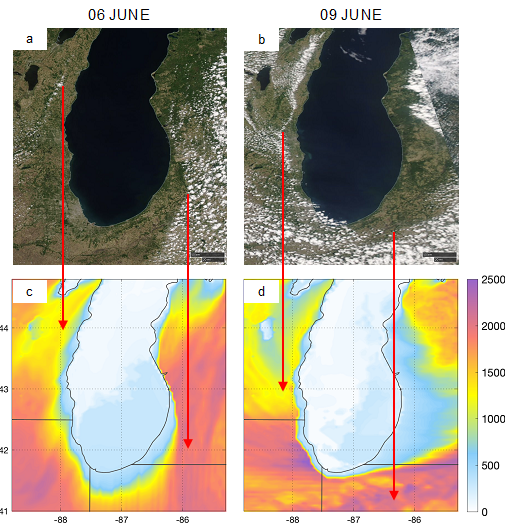https://www.esrl.noaa.gov/csd/aqrs/
20 minute presentation on the Lake Michigan Ozone Study 2017. Tuesday Nov 12, 2019.

Satellite imagery showing the lake breeze convergence front, and WRF-Chem modeling of the lake breeze. Image credit: Gonzalo Ferrada, Maryam Abdi, Greg Carmichael, Univ of Iowa
Abstract: The 2017 Lake Michigan Ozone Study (LMOS 2017) was a collaborative, multi‐agency field study of ozone chemistry and meteorology along the Wisconsin‐Illinois Lake Michigan shoreline using a combination of aircraft, ground‐based and ship‐based measurements. The overall goal of the study was to better understand ozone formation and transport around Lake Michigan to assist researchers and air quality managers who study, predict, and manage ozone concentrations in the region. Two particularly challenging study areas are understanding the factors that determine the size, location, timing, and intensity of ozone-rich air masses, and understanding the details of the chemistry and meteorology that create the sharp gradients in ozone concentrations often observed between the lakeshore and nearby inland locations.
Field activities were conducted from May 22‐June 22, 2017 and included two aircraft (one for remote sampling and one for in situ profiling), two ground based super sites (Sheboygan, WI and Zion, IL) outfitted with remote sensing and in situ measurements, three mobile sampling platforms measuring lakeshore‐inland ozone concentration gradients or conditions on the lake surface, and additional ground‐based remote sensing instruments collocated at several other shoreline monitoring locations. Air quality and meteorological forecasts provided flight planning guidance and in‐field evaluation of model prediction skill during the study.
Key findings from the study will be shared, with a focus on (a) key lessons from observations and post-campaign synthesis; (b) evaluation of WRF-Chem simulations at 4 km for meteorology, lake breeze, cloud state, and ozone.